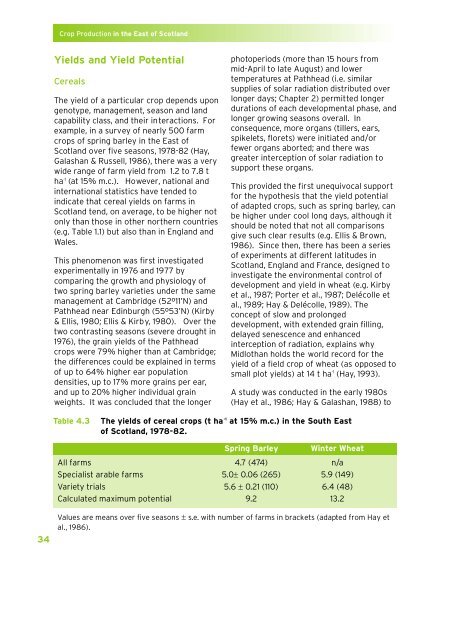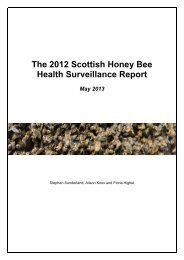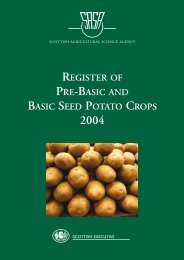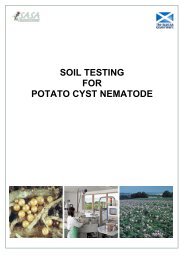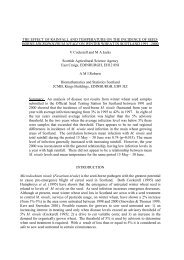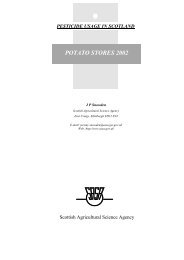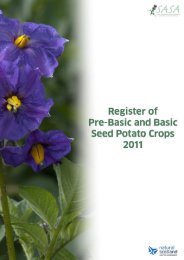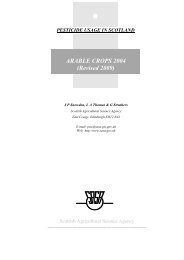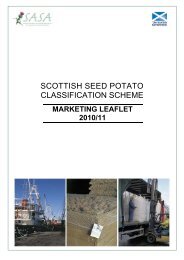You also want an ePaper? Increase the reach of your titles
YUMPU automatically turns print PDFs into web optimized ePapers that Google loves.
<strong>Crop</strong> <strong>Production</strong> <strong>in</strong> <strong>the</strong> <strong>East</strong> <strong>of</strong> <strong>Scotland</strong>Yields and Yield PotentialCerealsThe yield <strong>of</strong> a particular crop depends upongenotype, management, season and landcapability class, and <strong>the</strong>ir <strong>in</strong>teractions. Forexample, <strong>in</strong> a survey <strong>of</strong> nearly 500 farmcrops <strong>of</strong> spr<strong>in</strong>g barley <strong>in</strong> <strong>the</strong> <strong>East</strong> <strong>of</strong><strong>Scotland</strong> over five seasons, 1978-82 (Hay,Galashan & Russell, 1986), <strong>the</strong>re was a verywide range <strong>of</strong> farm yield from 1.2 to 7.8 tha -1 (at 15% m.c.). However, national and<strong>in</strong>ternational statistics have tended to<strong>in</strong>dicate that cereal yields on farms <strong>in</strong><strong>Scotland</strong> tend, on average, to be higher notonly than those <strong>in</strong> o<strong>the</strong>r nor<strong>the</strong>rn countries(e.g. Table 1.1) but also than <strong>in</strong> England andWales.This phenomenon was first <strong>in</strong>vestigatedexperimentally <strong>in</strong> 1976 and 1977 bycompar<strong>in</strong>g <strong>the</strong> growth and physiology <strong>of</strong>two spr<strong>in</strong>g barley varieties under <strong>the</strong> samemanagement at Cambridge (52º11’N) andPathhead near Ed<strong>in</strong>burgh (55º53’N) (Kirby& Ellis, 1980; Ellis & Kirby, 1980). Over <strong>the</strong>two contrast<strong>in</strong>g seasons (severe drought <strong>in</strong>1976), <strong>the</strong> gra<strong>in</strong> yields <strong>of</strong> <strong>the</strong> Pathheadcrops were 79% higher than at Cambridge;<strong>the</strong> differences could be expla<strong>in</strong>ed <strong>in</strong> terms<strong>of</strong> up to 64% higher ear populationdensities, up to 17% more gra<strong>in</strong>s per ear,and up to 20% higher <strong>in</strong>dividual gra<strong>in</strong>weights. It was concluded that <strong>the</strong> longerphotoperiods (more than 15 hours frommid-April to late August) and lowertemperatures at Pathhead (i.e. similarsupplies <strong>of</strong> solar radiation distributed overlonger days; Chapter 2) permitted longerdurations <strong>of</strong> each developmental phase, andlonger grow<strong>in</strong>g seasons overall. Inconsequence, more organs (tillers, ears,spikelets, florets) were <strong>in</strong>itiated and/orfewer organs aborted; and <strong>the</strong>re wasgreater <strong>in</strong>terception <strong>of</strong> solar radiation tosupport <strong>the</strong>se organs.This provided <strong>the</strong> first unequivocal supportfor <strong>the</strong> hypo<strong>the</strong>sis that <strong>the</strong> yield potential<strong>of</strong> adapted crops, such as spr<strong>in</strong>g barley, canbe higher under cool long days, although itshould be noted that not all comparisonsgive such clear results (e.g. Ellis & Brown,1986). S<strong>in</strong>ce <strong>the</strong>n, <strong>the</strong>re has been a series<strong>of</strong> experiments at different latitudes <strong>in</strong><strong>Scotland</strong>, England and France, designed to<strong>in</strong>vestigate <strong>the</strong> environmental control <strong>of</strong>development and yield <strong>in</strong> wheat (e.g. Kirbyet al., 1987; Porter et al., 1987; Delécolle etal., 1989; Hay & Delécolle, 1989). Theconcept <strong>of</strong> slow and prolongeddevelopment, with extended gra<strong>in</strong> fill<strong>in</strong>g,delayed senescence and enhanced<strong>in</strong>terception <strong>of</strong> radiation, expla<strong>in</strong>s whyMidlothan holds <strong>the</strong> world record for <strong>the</strong>yield <strong>of</strong> a field crop <strong>of</strong> wheat (as opposed tosmall plot yields) at 14 t ha -1 (Hay, 1993).A study was conducted <strong>in</strong> <strong>the</strong> early 1980s(Hay et al., 1986; Hay & Galashan, 1988) toTable 4.3The yields <strong>of</strong> cereal crops (t ha -1 at 15% m.c.) <strong>in</strong> <strong>the</strong> South <strong>East</strong><strong>of</strong> <strong>Scotland</strong>, 1978-82.Spr<strong>in</strong>g BarleyW<strong>in</strong>ter WheatAll farms 4.7 (474) n/aSpecialist arable farms 5.0± 0.06 (265) 5.9 (149)Variety trials 5.6 ± 0.21 (110) 6.4 (48)Calculated maximum potential 9.2 13.234Values are means over five seasons ± s.e. with number <strong>of</strong> farms <strong>in</strong> brackets (adapted from Hay etal., 1986).


